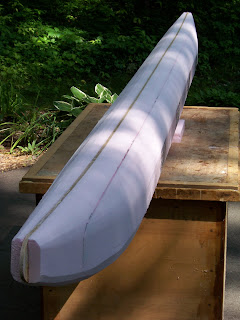
(click on images to enlarge)
I finally launched my first proa at the south end of Cannon Lake.
GLORY TIMES!
The
two wheeled dolly, shown above,
worked perfectly, even through soft beach sand. The
wae ends fit into forks in the top of the dolly cradle.
I used the same bungees to lash him together that I used to secure him on my roof rack, seen in the background. (Proas are male)
The bungee cord lashings are
FAST, EASY, SECURE and CONVENIENT.
Everything worked according to my clear and definite vision.
Cheers to Napoleon Hill!The water was crystal clear and cold. There was no one else on the lake. Storm clouds were blowing in from the North. It was near freezing, and getting dark.
I elected not to perform a capsize drill.

He was a beautiful sight to behold .
He tracked nicely, owing to his deep vee hull, and was very stable.
The wedge shaped
wae extensions worked beautifully, providing eye screw anchors for the bungee lashings, and elevating the akas above the water line.

LOOK AT HIM!
He goes fast with very little drag or resistance.
I can sit anywhere along the outrigger bench without submerging the bows, yet I can see how I can steer him by shifting my weight fore and aft.
I can lie down comfortably on the waka, between the akas.
The fore and aft outrigger spars interfered with paddling, but I can leave them off or move them out of the way.
The the
ama lashing system developed by Gary Dierking worked
BRILLIANTLY with the mooring cleats I mounted on the
akas, shown above. In this case, I used 3/16 inch polyester cord, not bungees.
I was able to sail along at a fair clip with just the wind resistance of my body.
I could used multiple corners on the outrigger grid for fulcrums, for sculling along with my double bladed paddle.
HE IS GOING TO BE FAST WITH A WING SAIL OR TWO.and now some preview images of my waka building saga . . .













































